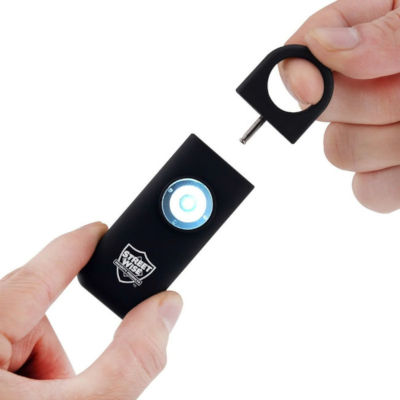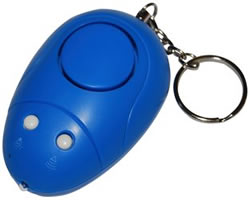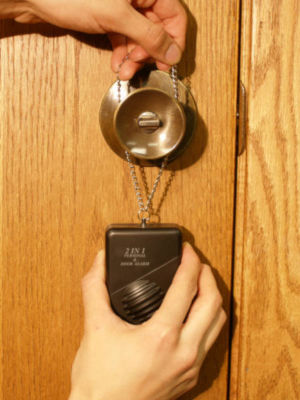Personal Security Alarms Guide

A midnight stroll or a quiet walk to your car parked at the office after work should not be a travel fraught with fear. In an uncertain world, personal security alarms have become indispensable tools in ensuring our safety along the way by deterring potential attackers and drawing attention during emergencies. In a manner similar to a wireless security system, these safety alarms work to fortify your personal space - anywhere, anytime. In the next few lines, we'll unveil how these small but powerful devices, such as the TBOTECH safety alarm, can turn you and your children from potential victims into empowered individuals ready to protect yourselves. Because your safety should never be an option— it is a right.
Personal security alarms are small devices that can emit a loud noise and/or flashing light when activated, designed to alert others nearby in an emergency situation. These devices, just like mini portable security systems, can be carried on a keychain, worn as a necklace or bracelet, or even attached in children's bags for extra safety. When the alarm is triggered, it emits a loud noise ranging from 120dB to 140dB, which can help disorient attackers and provide an opportunity for escape or for others to come to your aid. The loud noise can also attract attention in public places like parking lots, college campuses, office premises, or parks where bystanders may be able to intervene.
What is a Personal Security Alarm?
In an increasingly uncertain world where even a simple office commute or children's travel to school can be unnerving, personal safety has become a top priority for many individuals. One valuable tool available to help protect oneself and loved ones is a personal security alarm. So, what exactly is a personal security alarm?
Personal Security Device Sounds an Alarm
A personal security alarm, like the renowned TBOTECH security device, is a compact and portable device designed to emit a loud, attention-grabbing sound when activated. Its primary purpose is to deter potential attackers or alert others nearby in case of an emergency. Think of it as your personal wireless safety alarm system that can be carried on your keychain or in your pocket, ready to be activated at a moment's notice.
Imagine you're walking alone at night, or your children are returning home from school and suddenly feel unsafe. You can simply activate the personal security alarm by pulling a pin or pressing a button. Instantly, a piercing sound - often around 130-140 decibels - fills the air, drawing attention and potentially scaring away any would-be assailants.
The sound produced by these alarms, like other parts of your security system, is intentionally intense and ear-piercing because it serves two important purposes: first, it startles and disorients potential attackers, giving you crucial seconds to escape or call for help; second, it attracts the attention of nearby people who can assist you or alert authorities.
Now that we have a clear understanding of what a personal security alarm is and how it functions as your portable safety alarm, let's explore some of its features that make it an effective tool for personal safety.
Features of a Personal Security Alarm
Personal security alarms come with several features that enhance their effectiveness in protecting individuals. These features vary depending on the specific model and brand but generally include:
- Loud Siren: As mentioned earlier, personal security alarms produce loud sirens, typically ranging from 130 to 140 decibels (dB). This high-decibel output ensures that the sound will carry over long distances, making it effective in attracting attention even in noisy environments such as rush-hour traffic or bustling office corridors.
- Compact and Portable Design: Personal security alarms are designed to be compact and lightweight, making them easy to carry and convenient for everyday use. Many models are small enough to attach to keychains or fit comfortably in pockets, allowing quick access when needed. This handy design enables easy travel for adults and even children, making it an essential part of your security system.
- LED Lights and Other Alert Systems: Some personal security alarms also come equipped with LED lights. These lights serve two purposes: they can illuminate dark or unsafe areas, increasing visibility for the user, and they can act as a visual deterrent, drawing attention to potential threats. In a similar vein to how a security camera functions in a business security environment, these alarms use lights to monitor the area and intimidate potential threats. Some products even incorporate strobe lights, just like some high-end security cameras do, to provide an added level of deterrence.
- Durability, Weatherproofing, and Camera Features: Many personal security alarms are built to withstand rough handling and adverse weather conditions - much like a security camera monitors an environment, these devices unblinkingly keep providing the service they are designed for. Their durability ensures that the alarm remains functional when it matters most, even in challenging environments.
For instance, imagine you're out jogging when unexpected rain starts pouring heavily. Just as a weatherproof security camera would continue to monitor, with a weatherproof personal security alarm, you wouldn't have to worry about it malfunctioning or being damaged by moisture.
- Ease of Use and Importance in Business Security: Personal security alarms are designed to be user-friendly, much like a business security camera system that is tactfully positioned to monitor valuable products. They sport simple activation mechanisms such as buttons or pins that can be easily operated even in high-stress situations. They are meant to provide instant and hassle-free protection at the push of a button or the pull of a pin.
It's worth noting that while these features offer valuable benefits in terms of personal safety, personal security alarms should supplement other precautionary measures such as awareness of surroundings, self-defense training if desired, maintaining open lines of communication with trusted contacts, and even a business security setup, if necessary.
Now that we've explored the features that make personal security alarms effective tools for personal safety, let's take a closer look at how these devices actually work in different scenarios.
Personal security alarms serve as a valuable tool in enhancing personal safety and deterring potential threats, also functioning in the same realm as security cameras, which are essential tools for business security. But how do these devices actually work? Let's dive into the inner workings of personal security alarms.
- According to a 2022 market report, the Personal Alarm market is projected to reach $1.6 billion by 2027.
- A recent consumer survey revealed that in 60% of cases where a personal alarm was used in a threatening situation, the attacker was scared off.
- In a study conducted among joggers, bike commuters and night shift workers, nearly 70% agreed that carrying a personal alarm made them feel significantly safer during their commute or solo activity.
The Workings of Security Alarms
At its core, a personal security alarm is designed to emit a loud sound or activate other features like strobe lights, similar to a camera with a built-in strobe light used for business security, to attract attention and scare off attackers. These compact devices usually come in various colors to cater to users' preferences and are equipped with a button or switch that, when activated, triggers the alarm mechanism. Depending on the model, they may utilize different activation methods such as pulling a pin, pressing a button, or even utilizing motion and sound sensors, much like a security camera that detects movement.
The most common type of personal security alarm utilizes a high-decibel siren to startle and alert nearby individuals. With sound levels ranging from 100 decibels to an ear-piercing 130 decibels, these alarms, much like a camera with a built-in alarm or a safety alarm in a business security setup, can be heard from a considerable distance away, helping draw attention to the potential danger.
Pull Pin Safety Alarm
Alongside sound-based alarms, some personal security devices incorporate additional features such as strobe lights or bright LED lights. These visual indicators not only attract attention but can also disorient an attacker in low-light situations.
Now that we have a better understanding of how personal security alarms work, let's explore the various types available in the market.
When it comes to personal security alarms, there is a wide variety of options to suit different needs and preferences. Much like a business security setup where a variety of camera models and security products are available, personal security alarms too come in a diverse variety. Let's take a closer look at some popular types of personal security alarms:
Types of Personal Security Alarms
-
Keychain Alarms: These small and portable alarms are attached to your keychain for easy accessibility. They often feature a panic button that activates the alarm when pressed, ensuring you always have an immediate safety measure at hand, similar to how a security camera monitors an area round the clock.Wearable Alarms: Designed to be worn on your person, wearable alarms can be attached to clothing or accessories such as wristbands or necklaces. One popular option among men, for instance, includes personal safety alarms equipped with a flashlight for self-defense. They offer convenience and quick access to the alarm when needed, and products like this are making companies leading the sector in public safety innovation.
-
Motion Sensor Alarms: These alarms utilize motion detection technology, triggering the alarm when movement is detected in its vicinity. They are commonly used for home security purposes but can also be utilized for personal safety. Such alarms could even become important tools for police forces looking to improve neighborhood security.
-
Sound Sensor Alarms: Sound sensor alarms activate when they detect loud noises or screams. This type of alarm is useful in situations where you may be unable to manually trigger the alarm, such as during an altercation or physical attack. For self defense, these alarms are often paired with a powerful LED light feature to momentarily disorient attackers.
-
Combination Alarms: Some personal security alarms combine multiple features, such as incorporating both sound and light elements. In fact, some cutting-edge combination alarms produced by security-focused companies also have a built-in flashlight for additional utility. These versatile devices offer comprehensive protection options.
Remember, personal security alarms are not limited to these types alone, and each type has its own unique features and benefits. When considering the price and features, it's important to choose a personal security alarm that aligns with your lifestyle and provides the features you need to enhance your safety.
When it comes to personal security, motion and sound sensor alarms are a popular choice for individuals seeking protection against potential threats. These alarms detect any unusual movement or sounds within their range and trigger a loud alarm or other alert mechanisms, such as flashing lights. A key advantage of many personal safety alarms on the market today is having a flashlight feature, proving quite handy for both self defense and general use.
Imagine you're living alone in an apartment and want to ensure your safety while you sleep. Installing a motion and sound sensor alarm near the entrance or in strategic locations can provide an added layer of security. If someone were to enter your space without your knowledge, the alarm would immediately sound, alerting you and potentially the police to potential danger.
Motion and Sound Sensor Alarms
The effectiveness of motion and sound sensor alarms lies in their ability to detect unauthorized activity by capturing changes in the environment surrounding them. Additionally, features like built-in flashlights can act as a visual deterrent, further enhancing their self-defense capabilities.
For instance, let's say you have a valuable collection of antique jewelry stored in a glass cabinet at home. By installing a motion and sound sensor alarm near the cabinet, any attempt to tamper with it would trigger the alarm instantly, potentially scaring away thieves and alerting you or neighbors to the situation. Adding such precautionary measures will indeed be worth the price for the peace of mind it offers.
These alarms can be particularly useful when combined with other security measures like surveillance cameras or door/window sensors. The integration of these systems, led by innovative companies in the sector, creates a comprehensive approach, ensuring that any breach or unauthorized activity is detected promptly.
It's important to note that motion and sound sensor alarms should be strategically placed to maximize their effectiveness. Consider the layout of your space and identify areas that require enhanced security, such as entry points or high-value possessions. Some even come with a LED light feature, enhancing your self defense capability.
Now that we've explored motion and sound sensor alarms, let's turn our attention to another type of personal security alarm: anti-theft technology alarms.
Anti-Theft Technology Alarms
With advancements in technology, personal security alarms have also evolved to incorporate various anti-theft technologies. A revolutionary addition to the list includes alarms with a flashlight feature, created with the aim of helping individuals, especially men, take charge of their personal safety. These alarms utilize features that deter potential thieves and enhance the overall security of personal belongings. For instance, a keychain alarm with a built-in led flashlight is a handy tool that doesn't add much weight to your belongings but effectively improves their security.
Example of a Keychain Alarm with LED Light
One example of anti-theft technology alarms is those designed specifically for vehicles. Car theft remains a prevalent concern, particularly for seniors who may be perceived as easier targets, and having an alarm system equipped with features like immobilizers, GPS tracking, or remote control functionality can significantly improve the protection of your vehicle.
Consider this scenario: You park your car in a public parking lot while you shop, only to return and find it missing. With an anti-theft technology alarm system installed, you would have the ability to track your vehicle's location using GPS and even disable its movement remotely. The added security measures, like a siren for women drivers, act as a deterrent to thieves who might think twice before targeting your car.
Additionally, some personal security alarms come with built-in Bluetooth or Wi-Fi connectivity, allowing you to connect them with your smartphone or other smart devices. This integration enables real-time notifications and remote control over the alarm settings, providing convenience and peace of mind. Furthermore, some options come with a handy clip, allowing users to attach them to their clothing or handbags for easy access.
Imagine you're traveling solo and staying in a hotel room. By placing an anti-theft technology alarm on your luggage or attaching it to the door handle of your room, even the slightest tampering would trigger the alarm and alert you instantly. This added layer of security can help prevent unauthorized access to your belongings when you're not present.
Door Handle Alarm for Traveling Safety
It's important to note that while anti-theft technology alarms offer advanced features and additional security measures, they should be used in conjunction with other precautions such as secure locks, vigilance in public spaces, and regular maintenance of alarm systems.
Appropriate Usage of Personal Alarms
A personal security alarm can be a valuable tool to enhance personal safety and peace of mind in various situations. While they are often associated with women's safety, such as a siren for women, it is important to note that personal security alarms can be used by anyone in need of personal security. Whether you are a student walking home alone at night, an elderly person living alone, or a jogger who frequently uses secluded paths, having a personal security alarm can significantly increase your sense of security.
However, it is essential to understand when and how to use personal security alarms appropriately. These alarms should be treated as a preventive measure rather than a substitute for taking other necessary precautions for personal safety. Therefore, it's vital for adults, including seniors, to familiarize themselves with these devices and use them effectively for their protection.
For instance, imagine you are a college student who often walks home late at night after studying at the library. Carrying a personal security alarm, such as a keychain alarm with an LED flashlight, would provide you with an added layer of protection. If someone suspicious approaches you, activating the alarm will produce a loud and attention-grabbing sound, potentially scaring off the assailant and attracting the attention of others nearby. This can give you enough time to escape the situation or seek help without physically confronting the aggressor.
Navigate each situation cautiously and trust your instincts before engaging the alarm.
In situations where you feel threatened or unsafe, activating the personal security alarm can serve as a valuable deterrent. The loud siren produced by these devices can startle potential attackers and draw attention from people nearby, increasing your chances of getting help. However, it is important to consider the noise level and any possible collateral effects on innocent bystanders or yourself.
Let's say you find yourself in a crowded subway station and notice someone following you closely. You suspect that this individual may have malicious intent. In this case, it might be more suitable to alert security personnel or seek assistance from people around you rather than activating the personal security alarm. By doing so, you can ensure your safety without creating chaos or distress in the crowded environment.
When using personal security alarms, it is crucial to remember that they are not meant to replace other safety measures such as self-defense training, emergency preparedness, or utilizing well-lit areas with higher foot traffic. They should be seen as a complementary tool that adds an extra layer of protection.
Evaluating Security Alarms: Pros and Cons
Choosing the right personal security alarm requires careful evaluation just like selecting the perfect tool for a specific task. You wouldn't use a hammer for delicate embroidery work, nor would you rely on a sewing needle to fix a broken chair. Similarly, when evaluating personal security alarms, weighing their pros and cons is essential to make an informed decision based on your unique needs.
Let's explore some of the pros and cons associated with personal security alarms:
| Pros | Cons |
|---|---|
| Highly portable | Noise level concerns for the user |
| Easy to activate | False alarms |
| Attention-grabbing sound | Limited range of effectiveness |
| Can deter potential attackers | Dependence on battery |
Although personal security alarms are highly portable and can be easily carried on keychains or in pockets, one concern is the noise level that the user may experience. The loud siren produced by these alarms can potentially startle and disorient the person activating it, affecting their ability to assess the situation or take appropriate action. Care must be taken to ensure that the alarm doesn't cause any harm to the user.
Another potential drawback is the possibility of false alarms. Accidentally triggering the alarm in non-emergency situations can lead to unnecessary panic or desensitization for those around you. Additionally, personal security alarms may have limited effectiveness if there are significant barriers or distance between you and potential help.
On the positive side, personal security alarms are designed to produce an attention-grabbing sound that can deter potential attackers by scaring them off or attracting attention from nearby individuals who may come to your aid. This gives you a valuable window of opportunity to remove yourself from a dangerous situation or seek help.
One factor to consider is the dependence on battery power for these alarms. It is crucial to regularly check and replace batteries as needed to ensure that the alarm functions effectively when required.
When evaluating personal security alarms, it is crucial to assess how each factor aligns with your individual needs and circumstances. By considering these pros and cons, you can make an informed decision and choose a personal security alarm that best fits your requirements.
Click through to find an assortment of alarms for your safety.
Add your comment now!
Post Comment







